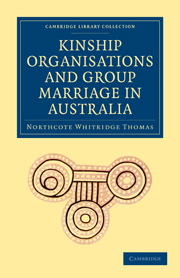Book contents
- Frontmatter
- PREFACE
- Contents
- BIBLIOGRAPHY
- INDEX TO ABBREVIATIONS
- CHAPTER I INTRODUCTORY
- CHAPTER II DESCENT
- CHAPTER III DEFINITIONS AND HISTORY
- CHAPTER IV TABLES OF CLASSES, PHRATRIES, ETC.
- CHAPTER V PHRATRY NAMES
- CHAPTER VI ORIGIN OF PHRATRIES
- CHAPTER VII CLASS NAMES
- CHAPTER VIII THEORIES OF THE ORIGIN OF CLASSES
- CHAPTER IX KINSHIP TERMS
- CHAPTER X TYPES OF SEXUAL UNIONS
- CHAPTER XI GROUP MARRIAGE AND MORGAN'S THEORIES
- CHAPTER XII GROUP MARRIAGE AND THE TERMS OF RELATIONSHIP
- CHAPTER XIII PIRRAURU
- CHAPTER XIV TEMPORARY UNIONS
- APPENDIX: ANOMALOUS MARRIAGES
- INDEX OF PHRATRY, BLOOD, AND CLASS NAMES
- INDEX OF SUBJECTS
- Plate section
CHAPTER VI - ORIGIN OF PHRATRIES
Published online by Cambridge University Press: 05 February 2012
- Frontmatter
- PREFACE
- Contents
- BIBLIOGRAPHY
- INDEX TO ABBREVIATIONS
- CHAPTER I INTRODUCTORY
- CHAPTER II DESCENT
- CHAPTER III DEFINITIONS AND HISTORY
- CHAPTER IV TABLES OF CLASSES, PHRATRIES, ETC.
- CHAPTER V PHRATRY NAMES
- CHAPTER VI ORIGIN OF PHRATRIES
- CHAPTER VII CLASS NAMES
- CHAPTER VIII THEORIES OF THE ORIGIN OF CLASSES
- CHAPTER IX KINSHIP TERMS
- CHAPTER X TYPES OF SEXUAL UNIONS
- CHAPTER XI GROUP MARRIAGE AND MORGAN'S THEORIES
- CHAPTER XII GROUP MARRIAGE AND THE TERMS OF RELATIONSHIP
- CHAPTER XIII PIRRAURU
- CHAPTER XIV TEMPORARY UNIONS
- APPENDIX: ANOMALOUS MARRIAGES
- INDEX OF PHRATRY, BLOOD, AND CLASS NAMES
- INDEX OF SUBJECTS
- Plate section
Summary
If a pre-phratry organisation developed into the system as we find it, it is a little difficult to see how selection can have operated, unless, indeed, as Mr Lang suggests, the phratries are transformed connubial groups, in which case they may have received new names. It is perhaps simpler to suppose that the cases of selection of phratry names cited above are those in which the organisation has been borrowed with full knowledge of its meaning. If this view is correct, no criticism of theories of the origin of phratries is possible from the point of view of the names actually existing, for we cannot say which, if any, are those which were evolved in the organisation which served as a model to the remainder.
Broadly speaking the theories of origin at present in the field may be reduced to two: in the first place, the conscious reformation theory, which supposes that man discovered the evils of in-and-in breeding, a point on which some discussion will be found in a later portion of this work. In the second place, there is the unconscious evolution theory put forward by Mr Lang, whose criticism of the opposing view makes it unnecessary to deal with the objections here.
Mr Lang's original theory took for its basis the hypothesis, put forward by the late Mr J. J. Atkinson, in Primal Law, of the origin of exogamy.
- Type
- Chapter
- Information
- Kinship Organisations and Group Marriage in Australia , pp. 63 - 70Publisher: Cambridge University PressPrint publication year: 2010First published in: 1906



